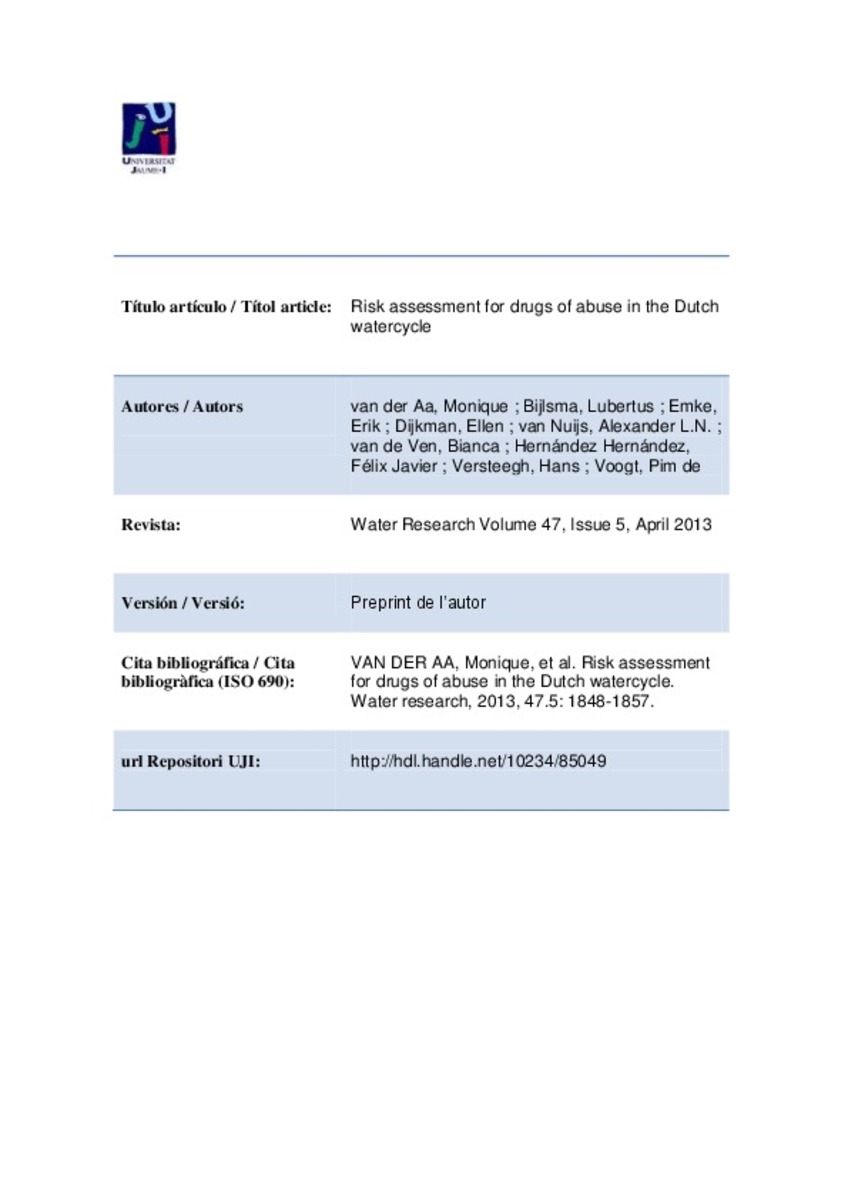Mostrar el registro sencillo del ítem
Risk assessment for drugs of abuse in the Dutch watercycle
| dc.contributor.author | Van der Aa, Monique | |
| dc.contributor.author | Bijlsma, Lubertus | |
| dc.contributor.author | Emke, Erik | |
| dc.contributor.author | Dijkman, Ellen | |
| dc.contributor.author | van Nuijs, Alexander | |
| dc.contributor.author | Van de Ven, Bianca | |
| dc.contributor.author | Hernandez, Felix | |
| dc.contributor.author | Versteegh, Hans | |
| dc.contributor.author | de Voogt, Pim | |
| dc.date.accessioned | 2014-03-03T09:52:48Z | |
| dc.date.available | 2014-03-03T09:52:48Z | |
| dc.date.issued | 2013-04 | |
| dc.identifier.citation | VAN DER AA, Monique, et al. Risk assessment for drugs of abuse in the Dutch watercycle. Water research, 2013, 47.5: 1848-1857. | ca_CA |
| dc.identifier.uri | http://hdl.handle.net/10234/85049 | |
| dc.description.abstract | A screening campaign of drugs of abuse (DOA) and their relevant metabolites in the aqueous environment was performed in the Netherlands. The presence of DOA, together with the potential risks for the environment and the possible human exposure to these compounds through consumption of drinking water was investigated. Sewage water (influent and effluent), surface water of the rivers Rhine and Meuse, and drinking water (raw and finished) were analysed by four different laboratories using fully in-house validated methods for a total number of 34 DOA and metabolites. In this way, data reported for several compounds could also be confirmed by other laboratories, giving extra confidence to the results obtained in this study. In total 17 and 22 DOA were detected and quantified in influent and effluent sewage samples, respectively. The tranquilizers oxazepam and temazepam, and cocaine and its metabolite benzoylecgonine were found in high concentrations in sewage water. Nine compounds were possibly not efficiently removed during treatment and were detected in surface waters. The results indicated that substantial fractions of the total load of DOA and metabolites in the rivers Rhine and Meuse enter the Netherlands from abroad. For some compounds, loads appear to increase going downstream, which is caused by a contribution from Dutch sewage water effluents. As far as data are available, no environmental effects are expected of the measured DOA in surface waters. In raw water, three DOA were detected, whereas in only one finished drinking water out of the 17 tested, benzoylecgonine was identified, albeit at a concentration below the limit of quantification (<1 ng/L). Concentrations were well below the general signal value of 1 μg/L, which is specified for organic compounds of anthropogenic origin in the Dutch Drinking Water Act. | ca_CA |
| dc.format.extent | 9 p. | ca_CA |
| dc.format.mimetype | application/pdf | ca_CA |
| dc.language.iso | eng | ca_CA |
| dc.publisher | Elsevier | ca_CA |
| dc.relation.isPartOf | Water Research Volume 47, Issue 5, April 2013 | ca_CA |
| dc.rights | Copyright © 2014 Elsevier B.V. except certain content provided by third parties | ca_CA |
| dc.rights.uri | http://rightsstatements.org/vocab/InC/1.0/ | * |
| dc.subject | Drugs of abuse | ca_CA |
| dc.subject | Sewage water | ca_CA |
| dc.subject | Surface water | ca_CA |
| dc.subject | Drinking water | ca_CA |
| dc.subject | Environmental risk characterization | ca_CA |
| dc.title | Risk assessment for drugs of abuse in the Dutch watercycle | ca_CA |
| dc.type | info:eu-repo/semantics/article | ca_CA |
| dc.identifier.doi | http://dx.doi.org/10.1016/j.watres.2013.01.013 | |
| dc.rights.accessRights | info:eu-repo/semantics/openAccess | ca_CA |
| dc.relation.publisherVersion | http://www.sciencedirect.com/science/article/pii/S0043135413000304 | ca_CA |
| dc.type.version | info:eu-repo/semantics/submittedVersion |
Ficheros en el ítem
Este ítem aparece en la(s) siguiente(s) colección(ones)
-
IUPA_Articles [306]







